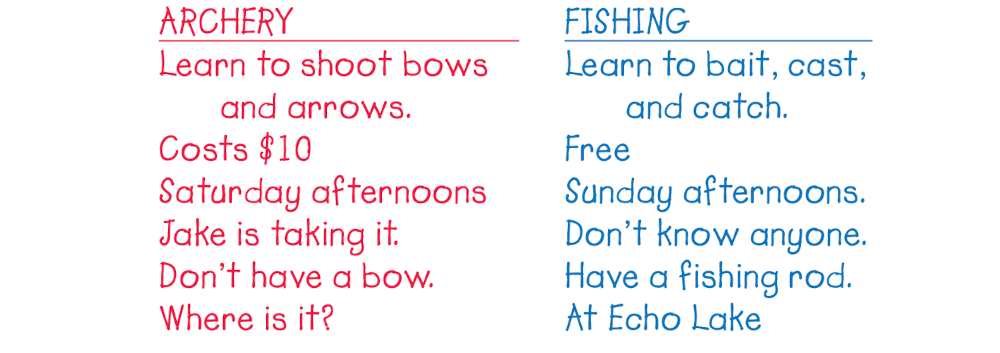WT 292
Page 292
Thinking Clearly
Escalators are amazing inventions: moving stairways that go up and down and carry many people at once. But they didn’t always exist. Someone had to think them into being.
Thinking Things into Being
People solve problems by thinking clearly. They gather facts, analyze and organize them, explore options, and then make good decisions. They sometimes even create amazing inventions!

WT 293
Page 293
Solving Problems
Imagine the problem-solving process that led to the invention of escalators.
1. Name the problem.
Lots of people need to change floors quickly.
2. List everything you know about the problem.
Stairs are hard for some people.
Elevators are too slow.
Upstairs stores are losing customers.
Elevators are too slow.
Upstairs stores are losing customers.
3. Think of ways to solve the problem.
We could put in trampolines.
We could use pulleys and slides.
We could make stairs that work like elevators—moving staircases that go up and down.
We could use pulleys and slides.
We could make stairs that work like elevators—moving staircases that go up and down.
4. Choose the best plan and try it out.
Let’s invent an escalator!
5. Ask yourself: How did the plan work?
Escalators safely carry people up and down.
People don’t wait for an escalator—just get on.
Escalators are silent, fast, and a little fun, too!
-
Escalators safely carry people up and down.
People don’t wait for an escalator—just get on.
Escalators are silent, fast, and a little fun, too!
WT 294
Page 294
Making Decisions
Sometimes you have a decision to make, and you’re not sure what to do. Here’s how to think clearly.
1. Write down what you have to decide.
Should I sign up for archery or for fishing?
2. List the facts.
List facts, feelings, and any questions you have.
 © Thoughtful Learning 2025
© Thoughtful Learning 2025
3. Find answers to any questions.
Ask someone where the archery class meets. Ask friends which class would be better.
4. Make your decision.
Put a ★ next to each “good” thing on your list. You might decide to do the activity with the most ★’s. Sometimes, one good thing—like being with your friend Jake—might be more important to you than anything else. Or maybe you’ll decide to do both!
-
List facts, feelings, and any questions you have.

-
Ask someone where the archery class meets. Ask friends which class would be better.
-
Put a ★ next to each “good” thing on your list. You might decide to do the activity with the most ★’s. Sometimes, one good thing—like being with your friend Jake—might be more important to you than anything else. Or maybe you’ll decide to do both!
WT 295
Page 295
Using Facts and Opinions
Do you know the difference between a fact and an opinion? A fact is a statement that can be proven. An opinion is a personal thought or feeling that can’t be proven. To think clearly, you need to know the difference between facts and opinions.
Fact: The city offers archery and fishing. Opinion: Archery is cooler than fishing.
Fact: My dad drank coffee this morning. Opinion: Coffee tastes horrible.
Fact vs. Opinion
Your friend says, “Downtown Theater is showing Rescue Dogs. We should go this afternoon!”
The first statement is a fact: “Downtown Theater is showing Rescue Dogs.” You can prove that statement by checking the showtimes online. The second statement is only an opinion: “We should go this afternoon!” It tells what your friend would like to do, but maybe you should do something else—like attend another friend’s birthday party.
Tip
Opinions are great. You and your friend might love Rescue Dogs but other people might not. That’s okay. People can have different opinions—just not different facts.
WT 296
Page 296
Sticking to the Facts
Sometimes it’s tough to tell if a statement is a fact. “The sky is blue” seems like a fact—but often the sky is black, or orange, or white, or gray. “On a clear day, the sky is blue,” is a fact. Here are other tricky statements:
A statement is not a fact
just because most people agree with it.

Most Americans might prefer miles, but most people in the rest of the world prefer kilometers. Both are opinions. Miles and kilometers are both just measurements of distance.
A statement is not a fact
if it predicts the future.

This statement is an opinion. Nobody can be sure how the team will do. If, instead, you said, “My soccer team was undefeated last season,” that statement can be checked against records. It is either true or false. It is not an opinion.
WT 297
Page 297
A statement is not a fact
if it is a half-truth.

This is only half true. Studying certainly helps people get A’s, but it’s not the only factor. If you study all night and fall asleep during the test, you might not get an A. Here’s how to turn this statement into a fact: Studying before a test helps people perform well. (By the way, so does being well rested.)
A statement is not a fact
if it stretches the truth.
 © Thoughtful Learning 2025
© Thoughtful Learning 2025
If you waited forever, you’d still be waiting. It might have felt like forever, but that feeling makes the statement an opinion. This statement could be a fact: “We waited two minutes and 23 seconds for the light to turn green.”
Tip
If you want someone to agree with your opinion, support it with facts.
Opinion: “The Packers are great!”
Fact: “They have the most wins in the NFC North.”

If you want someone to agree with your opinion, support it with facts.
-
Opinion: “The Packers are great!”
Fact: “They have the most wins in the NFC North.”